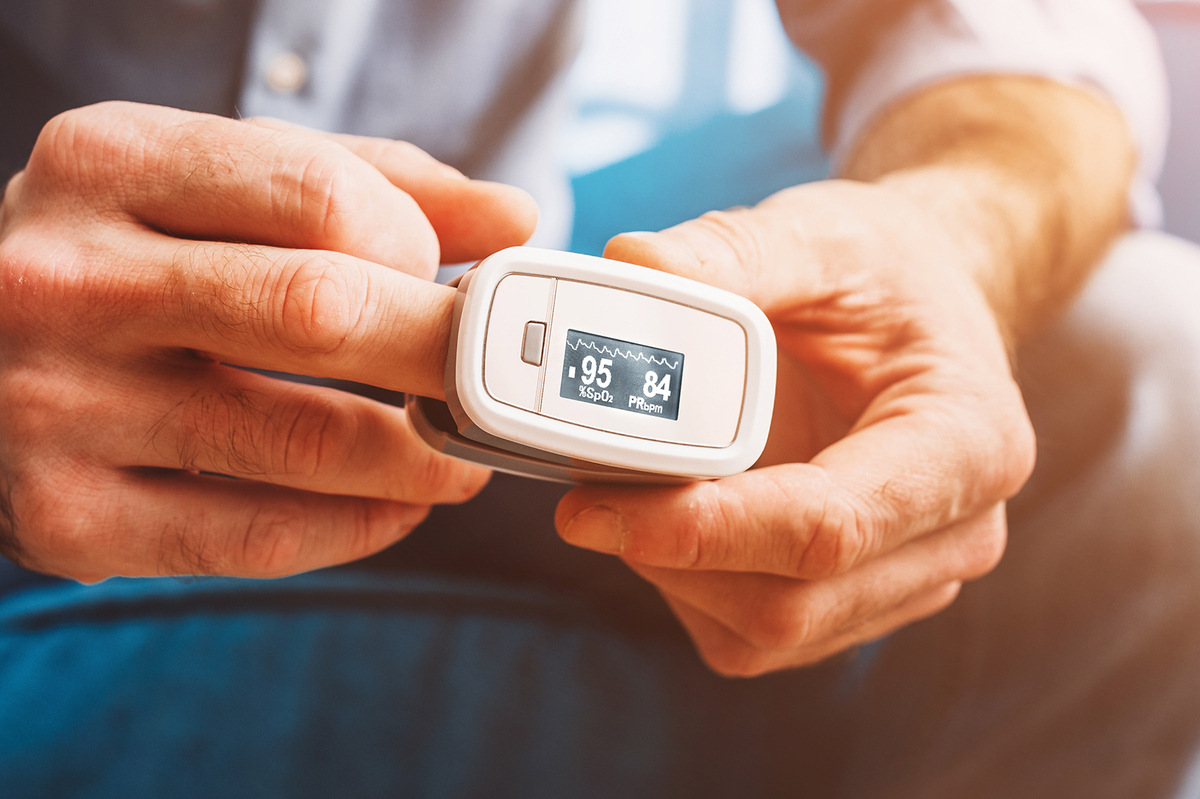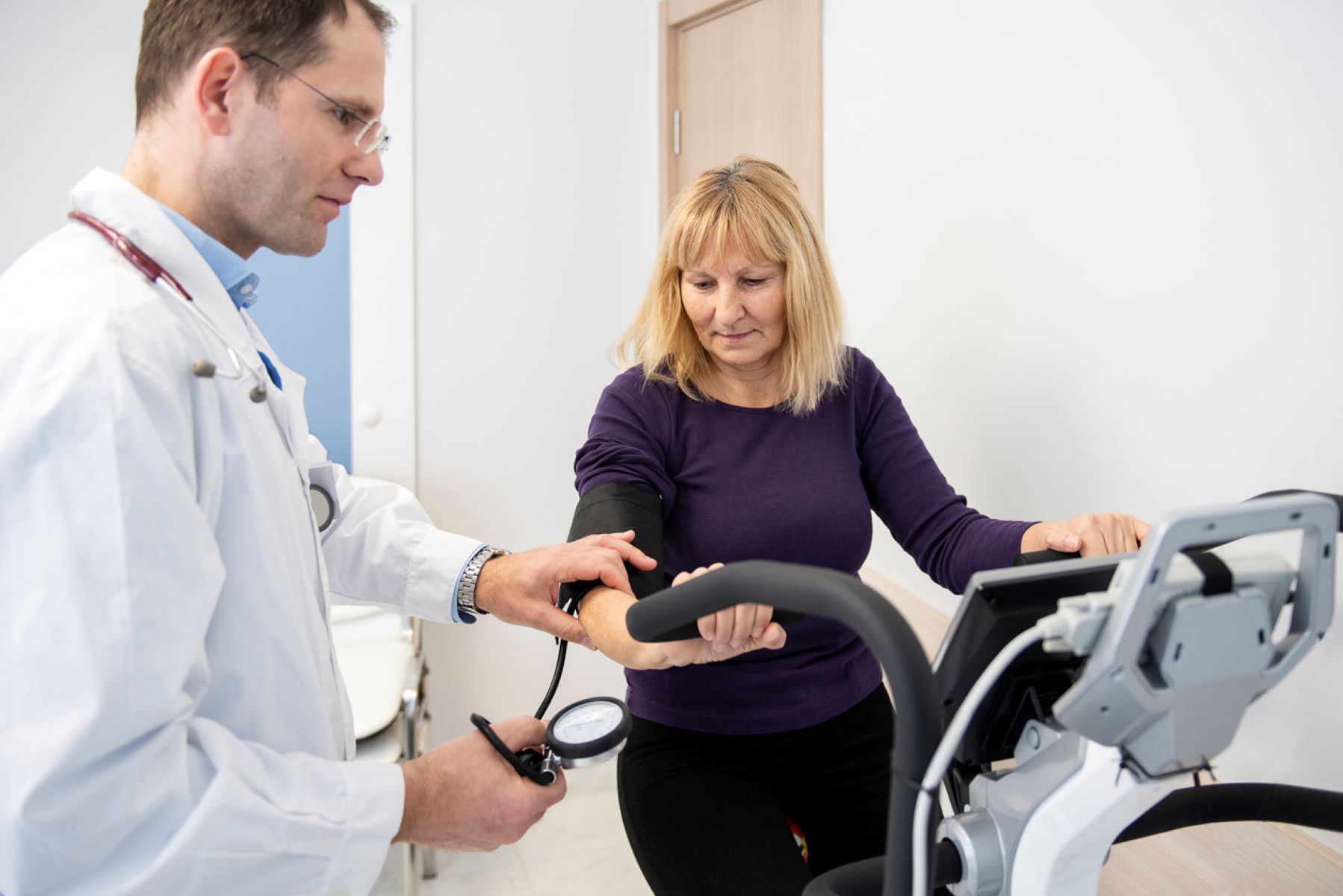Home>Misc>Featured>What Are Normal Blood Oxygen Levels During Exercise


Featured
What Are Normal Blood Oxygen Levels During Exercise
Published: October 2, 2023
Discover what normal blood oxygen levels should be during exercise and how they can impact your overall health. Stay on top of your fitness goals with our featured article.
Introduction
Welcome to the world of physical fitness and exercise! Whether you are a seasoned athlete or just starting your fitness journey, understanding the importance of blood oxygen levels during exercise is crucial for optimizing performance and overall health. During physical activity, your body undergoes significant changes to meet the increased demand for oxygen. Monitoring your blood oxygen levels can provide valuable insights into your fitness level and help prevent potential health risks.
Blood oxygen levels refer to the amount of oxygen being carried by red blood cells from the lungs to the rest of the body. Oxygen is an essential component for the proper functioning of our cells and organs, especially during exercise when our energy demands are higher. Efficient oxygen delivery is vital for optimal performance, as inadequate levels can lead to fatigue, dizziness, and even more severe complications.
Understanding how blood oxygen levels fluctuate during exercise can help you gauge your fitness level, prevent overexertion, and ensure that you are exercising safely. Therefore, it is essential to be aware of what constitutes normal blood oxygen levels during exercise and how to monitor them effectively.
Understanding Blood Oxygen Levels
Before diving into the specific blood oxygen levels during exercise, let’s first understand what blood oxygen levels represent. Blood oxygen levels are measured by a parameter called oxygen saturation or SpO2, which refers to the percentage of oxygen-saturated hemoglobin in the blood.
Hemoglobin is the protein in red blood cells that carries oxygen from the lungs to the body’s tissues. When it binds with oxygen, hemoglobin becomes oxygenated, and a higher level of oxygen saturation is achieved. Oxygen saturation levels are typically measured in arterial blood, and a healthy individual at rest would have a saturation level of 95-100%.
During exercise, however, oxygen demands increase due to the higher energy requirements of the muscles. This prompts several physiological responses to ensure an adequate supply of oxygen to the working muscles. As a result, blood oxygen levels may fluctuate to meet these increased demands.
It’s important to note that blood oxygen levels vary on an individual basis and can depend on various factors such as age, overall health, fitness level, and environmental conditions. However, understanding the normal range of blood oxygen levels during exercise can provide a general guideline for assessing your performance and overall health.
Monitoring blood oxygen levels during exercise is typically done using wearable fitness trackers or pulse oximeters. These devices use light absorption technology to estimate the oxygen saturation levels by measuring the differences in light absorption between oxygenated and deoxygenated blood.
By understanding and tracking your blood oxygen levels during exercise, you can gain valuable insights into your cardiovascular fitness, identify potential limitations, and ensure that you’re engaging in safe and effective workouts.
Importance of Blood Oxygen Levels During Exercise
Optimal blood oxygen levels play a vital role in maximizing your exercise performance and promoting overall health. Here’s why monitoring and maintaining proper blood oxygen levels during exercise is so important:
- Enhanced Performance: During physical activity, your muscles require an increased supply of oxygen to support energy production. Higher blood oxygen levels help deliver oxygen-rich blood to the working muscles, improving their efficiency and endurance. This can result in better athletic performance, increased stamina, and improved overall exercise capacity.
- Reduced Fatigue: Inadequate oxygen supply to the muscles can lead to fatigue and decreased exercise performance. By maintaining optimal blood oxygen levels, you can delay the onset of fatigue and sustain higher energy levels throughout your workout, allowing you to push harder and achieve greater results.
- Improved Recovery: After intense exercise, ensuring adequate oxygen supply is crucial for the recovery process. Oxygen plays a key role in removing waste products, such as lactic acid, from the muscles, reducing muscle soreness, and promoting faster recovery. Monitoring blood oxygen levels can help ensure that you are supplying enough oxygen to aid in the recovery process.
- Cardiovascular Health: Regular exercise helps strengthen your heart and cardiovascular system. Monitoring blood oxygen levels during exercise can provide insights into the efficiency of oxygen delivery to the heart and other organs. Consistently maintaining optimal blood oxygen levels can reduce the risk of cardiovascular diseases and improve overall heart health.
- Safety: Monitoring blood oxygen levels during exercise is especially crucial for individuals with respiratory conditions, such as asthma or chronic obstructive pulmonary disease (COPD). By understanding your blood oxygen levels, you can exercise within safe limits and prevent potential health complications or exacerbation of existing respiratory conditions.
By recognizing the importance of blood oxygen levels during exercise and taking steps to maintain optimal levels, you can enhance your performance, improve your overall fitness, and reduce the risk of exercise-related health complications.
Factors Affecting Blood Oxygen Levels During Exercise
Several factors can influence blood oxygen levels during exercise. Understanding these factors can help you make informed decisions and effectively manage your workouts. Here are some key factors that can affect blood oxygen levels:
- Fitness Level: Your fitness level plays a crucial role in determining how efficiently your body uses oxygen during exercise. Well-trained individuals tend to have higher aerobic capacity and better oxygen utilization compared to those who are less fit. As a result, their blood oxygen levels may remain relatively stable or even increase during exercise.
- Altitude: Exercising at high altitudes where oxygen levels are lower can significantly impact blood oxygen levels. At higher altitudes, the concentration of oxygen in the air is reduced, making it more challenging for your body to obtain sufficient oxygen during exercise. This can cause a decrease in blood oxygen levels and potentially lead to symptoms of altitude sickness.
- Intensity and Duration of Exercise: The intensity and duration of exercise directly impact blood oxygen levels. Higher-intensity workouts require more oxygen uptake, increasing the demand for oxygen in the muscles. Prolonged exercise sessions can also lead to a progressive decline in blood oxygen levels as oxygen is continuously utilized by the muscles.
- Temperature and Humidity: Environmental factors, such as temperature and humidity, can affect blood oxygen levels during exercise. Hot and humid conditions can make it harder for your body to regulate its core temperature. This can lead to increased sweating and fluid loss, potentially affecting blood volume and oxygen-carrying capacity.
- Health Conditions: Underlying health conditions can impact how well your body delivers and utilizes oxygen during exercise. Respiratory disorders, circulatory problems, anemia, and other chronic conditions can affect blood oxygen levels. It is important to consult with a healthcare professional if you have any existing health concerns that may affect your exercise and blood oxygen levels.
Keep in mind that these factors can vary between individuals, and it’s important to listen to your body and make adjustments accordingly. Monitoring your blood oxygen levels during exercise can help you understand how these factors impact your performance and make informed decisions to optimize your workouts.
Normal Blood Oxygen Levels During Exercise
Normal blood oxygen levels during exercise can vary depending on several factors, including individual fitness levels, age, and overall health. However, as a general guideline, a healthy individual with good cardiovascular fitness can expect to maintain blood oxygen levels within the range of 90-100% during exercise.
It’s important to note that blood oxygen levels may vary based on the intensity and duration of your workout. During high-intensity exercise or prolonged endurance activities, blood oxygen levels may drop slightly below the normal range, typically within the range of 85-95%. This slight decrease is a natural response to meet the increased oxygen demand and is generally well-tolerated by healthy individuals.
If your blood oxygen levels fall below 85% during exercise, it may indicate inadequate oxygen delivery or potential underlying health issues. In such cases, it is advisable to consult with a healthcare professional for further evaluation and guidance.
While monitoring blood oxygen levels can provide useful insights into your exercise performance, it’s important not to solely rely on this measure. Pay attention to other cues from your body, such as your breathing rate, heart rate, and overall comfort level during exercise. These factors collectively provide a more comprehensive understanding of your exercise intensity and performance.
Every individual is unique, and what may be considered normal blood oxygen levels for one person may not be the same for another. If you have any concerns or questions about your blood oxygen levels or exercise performance, it is always best to consult with a healthcare professional for personalized guidance.
By understanding and monitoring your blood oxygen levels during exercise, you can gain valuable insights into your fitness level and make informed decisions to optimize your workouts and ensure your safety and well-being.
Monitoring Blood Oxygen Levels During Exercise
Monitoring blood oxygen levels during exercise can provide valuable insights into your body’s response to physical activity and help you make informed decisions about your workouts. Here are a few methods for monitoring blood oxygen levels during exercise:
- Wearable Fitness Trackers: Many wearable devices, such as fitness watches and activity trackers, come equipped with built-in SpO2 sensors that can estimate your blood oxygen levels. These devices use optical sensors to measure light absorption through your skin, providing real-time data on your blood oxygen saturation levels during exercise.
- Pulse Oximeters: A more accurate way to measure blood oxygen levels is through a dedicated pulse oximeter. These small devices typically clip onto your fingertip or earlobe and use light absorption technology to measure oxygen saturation levels. They can provide quick and reliable readings, making them ideal for monitoring blood oxygen levels during exercise.
- Mobile Apps: There are also mobile applications available that claim to measure blood oxygen levels using the camera and flash of your smartphone. While these apps may provide some general information, their accuracy is not as reliable as dedicated pulse oximeters or wearable fitness trackers.
- Perceived Exertion: Monitoring your perceived exertion can also give you an indication of your blood oxygen levels during exercise. Pay attention to how difficult the exercise feels, your breathing rate, and any signs of fatigue or dizziness. If you’re struggling to maintain intensity or experiencing extreme difficulty, it may be a sign that your blood oxygen levels are affected.
It’s important to note that while these monitoring methods can provide valuable insights, they are not a substitute for professional medical advice. Consult with a healthcare professional to better understand how to monitor your blood oxygen levels during exercise and interpret the data in relation to your overall health and well-being.
Keep in mind that blood oxygen levels can fluctuate due to various factors, including exercise intensity, duration, and individual differences. Understanding your baseline blood oxygen levels at rest can also help you interpret changes during exercise more accurately.
By regularly monitoring your blood oxygen levels during exercise, you can better understand your body’s response to physical activity, make adjustments to your workout intensity if necessary, and ensure that you are exercising within safe limits.
Effects of Abnormal Blood Oxygen Levels During Exercise
Abnormal blood oxygen levels during exercise can have a significant impact on your performance, comfort, and overall health. Here are some effects of both low and high blood oxygen levels during exercise:
- Low Blood Oxygen Levels:
- If your blood oxygen levels drop below normal during exercise, it can lead to feelings of fatigue, weakness, and shortness of breath. This can significantly impair your exercise performance and limit your ability to sustain high-intensity workouts.
- It may also result in dizziness, lightheadedness, and an increased heart rate as your body tries to compensate for the decreased oxygen supply.
- In more severe cases, low blood oxygen levels can lead to hypoxemia, a condition characterized by an insufficient amount of oxygen in the bloodstream. Hypoxemia can cause confusion, chest pain, and even loss of consciousness, requiring immediate medical attention.
- High Blood Oxygen Levels:
- If your blood oxygen levels are excessively high during exercise, it usually indicates hyperventilation or over-ventilation. This can occur when you are breathing too rapidly or deeply, causing an imbalance in the carbon dioxide levels in your body.
- While high blood oxygen levels themselves may not directly cause harm, the associated decrease in carbon dioxide levels can lead to symptoms such as lightheadedness, tingling sensations, and muscle spasms.
- In extreme cases, over-ventilation can result in alkalosis, a condition characterized by an excessively alkaline pH level in the blood. Alkalosis can cause confusion, muscle weakness, and irregular heart rhythms, requiring medical attention.
It’s important to maintain optimal blood oxygen levels during exercise to ensure efficient oxygen delivery to your muscles and organs. If you experience recurrent symptoms of low or high blood oxygen levels during exercise, it is essential to consult with a healthcare professional for a proper evaluation and guidance.
Individuals with pre-existing respiratory conditions, such as asthma or chronic obstructive pulmonary disease (COPD), should be particularly cautious and work closely with their healthcare provider to manage their exercise routine and monitor blood oxygen levels effectively.
By being aware of the potential effects of abnormal blood oxygen levels and seeking appropriate medical guidance when needed, you can exercise safely, optimize your performance, and reduce the risk of complications during physical activity.
Tips for Maintaining Optimal Blood Oxygen Levels During Exercise
Maintaining optimal blood oxygen levels during exercise is crucial for maximizing performance, preventing fatigue, and promoting overall health. Here are some tips to help you maintain healthy blood oxygen levels during your workouts:
- Warm-Up: Start your exercise session with a proper warm-up routine. Gradually increase the intensity of your workout to allow your body to adjust and ensure efficient oxygen uptake.
- Breathing Techniques: Practice proper breathing techniques during exercise. Take deep, controlled breaths to fully expand your lungs and optimize oxygen intake. Exhale fully to eliminate carbon dioxide effectively.
- Stay Hydrated: Proper hydration is essential for maintaining optimal blood volume and oxygen-carrying capacity. Drink water throughout your workout and ensure that you are adequately hydrated before and after exercise.
- Monitor Your Intensity: Pay attention to your exercise intensity and avoid pushing yourself beyond your limits. Overexertion can lead to hyperventilation and negatively affect blood oxygen levels. Listen to your body and adjust your workout intensity accordingly.
- Consider Altitude: If you are exercising at high altitudes, give your body time to acclimate. The lower oxygen levels at higher altitudes can affect blood oxygen saturation levels. Start with lower intensity workouts and gradually increase as your body adjusts.
- Include Aerobic Exercises: Regular aerobic exercises, such as jogging, cycling, or swimming, can improve cardiovascular fitness and increase your body’s efficiency in utilizing oxygen. This can help maintain optimal blood oxygen levels during exercise.
- Take Recovery Breaks: Allow yourself sufficient recovery breaks during long or intense exercise sessions. This ensures your body has time to replenish oxygen levels and prevents overexertion.
- Manage Underlying Health Conditions: If you have pre-existing health conditions that may affect your blood oxygen levels, work closely with your healthcare provider to manage your exercise routine effectively and ensure your safety.
- Seek Professional Guidance: If you have concerns about your blood oxygen levels or exercise performance, consult with a healthcare professional or a certified fitness trainer. They can provide personalized recommendations based on your individual needs and goals.
Remember, maintaining optimal blood oxygen levels is essential for maximizing your exercise performance and ensuring your safety during physical activity. By incorporating these tips into your workouts and staying attuned to your body’s needs, you can optimize your exercise routine and reap the benefits of improved fitness and overall well-being.
Conclusion
Maintaining optimal blood oxygen levels during exercise is crucial for enhancing performance, preventing fatigue, and promoting overall health. By understanding the significance of blood oxygen levels and monitoring them effectively, you can gain valuable insights into your fitness level and exercise capacity.
Throughout this article, we explored the importance of blood oxygen levels during exercise and how they can impact your performance and well-being. We discussed factors that can affect blood oxygen levels, the normal range during exercise, and the potential effects of abnormal levels.
To maintain optimal blood oxygen levels during exercise, it’s important to focus on warm-up routines, proper breathing techniques, hydration, and monitoring exercise intensity. Additionally, considering factors like altitude, including aerobic exercises, taking recovery breaks, and managing underlying health conditions can significantly contribute to maintaining healthy blood oxygen levels.
Always be attentive to your body’s signals during exercise. If you experience symptoms of low or high blood oxygen levels, it is advisable to consult with a healthcare professional for appropriate evaluation and guidance.
Remember that each individual is unique, and what may be considered normal or optimal for one person may differ for another. It’s essential to listen to your body and make adjustments based on your own needs and limitations.
Incorporate the tips and information shared in this article into your exercise routine to optimize your workouts, improve your fitness level, and ensure your safety and well-being. By maintaining optimal blood oxygen levels, you can reach new heights in your physical fitness journey and enjoy the many benefits that come with a healthy and active lifestyle.









